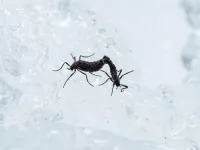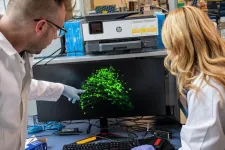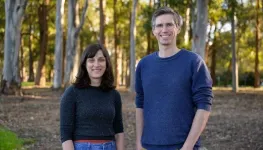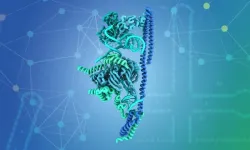(Press-News.org) ANN ARBOR, Mich. — A cardiac surgery and heart failure team at the University of Michigan implanted a novel mechanical heart pump into a patient as part of a clinical trial that will compare it to the only device currently used to treat end-stage heart failure.
“This trial presents an opportunity to assess novel technology as we explore a potential new treatment for advanced heart failure — a life-threatening condition with extremely limited therapeutic opportunities available,” said Francis Pagani, M.D., Ph.D., national lead investigator for the trial and cardiac surgeon at the U-M Health Frankel Cardiovascular Center.
Of 6 million Americans with heart failure, thousands are either waiting for a heart transplant or need a transplant but are not eligible.
Doctors often treat these patients with a ventricular assist device, an implantable heart pump that assists the weak muscle of the heart’s left ventricle in pumping blood throughout the body. Once used as a stopgap before transplant, VADs are now increasingly used as an alternative long-term therapy in place of heart transplantation.
The study, called INNOVATE (Investigation of a Novel, magNetically levitated VAD for the treatment of refractOry left Ventricular heArT failure), is the first test of the BrioVAD, a LVAD developed by BrioHealth Solutions, Inc.
The first patient to receive the BrioVAD at U-M was a woman from Monroe, Mich.
The trial aims to enroll participants with heart failure whose left ventricles have weakened to 25% or less of normal blood-pumping power – a measure called left ventricular ejection fraction. To qualify, patients must have worsening heart failure despite receiving optimal treatment with medications.
Two-thirds of the participants will be randomly assigned to receive the BrioVAD, while one-third will receive Abbott’s HeartMate 3, which is the only device regularly offered to patients as a short- and long-term treatment at this time.
The HeartMate 3 was first approved by the U.S. Food and Drug Administration in 2017. The BrioVAD has received an investigational device exemption from the FDA for use in the INNOVATE trial directly comparing the two devices, and it has been approved for commercial use in China.
Abbott announced in January 2024 that it would stop producing its other FDA-approved LVAD offering, the HeartMate II, by 2026.
“Having only one device on the market for any condition is not ideal for patients,” said Abbas Bitar, M.D., principal site investigator for the trial and clinical assistant professor of internal medicine-cardiology at U-M Medical School.
“If a malfunction or supply chain issue were to arise, patients would be left without an option. It’s vitally important to have other choices available for our patients in that event.”
Both the BrioVAD and HeartMate 3 use a technology that magnetically levitates a rotor inside the pump housing, to reduce damage as it turns and pumps blood to the body. The new device spins at a slightly slower speed in an effort to further reduce harm to the blood, according to BrioHealth Solutions.
The BrioVAD pump is around 20% smaller than the HeartMate 3 and has a slightly narrower driveline, the cable that runs from the pump through the skin to the battery pack worn outside the body.
HeartMate 3’s pair of batteries provides up to 17 hours of uninterrupted power. BrioVAD offers up to 12 hours of charge; however, it only uses one battery and is less for the patient to carry.
In April 2024, the U.S. Food and Drug Administration recalled HeartMate II and HeartMate 3 due to a buildup of biological material that caused blockages as blood exits the device pump.
“Despite the recall, HeartMate 3 has achieved the best outcomes to date for patients with no other option for treatment and has set new, higher standards of patient outcomes to compare to all future devices,” Pagani said.
“It has a very low rate of adverse outcomes compared to past VADs that had traditionally high complication burdens, including driveline infections and strokes.”
Eventually, up to 40 U.S. health systems are expected to take part in the trial. The goal is to have a total of 780 participants enrolled in INNOVATE.
“While the use of VADs has grown over the years, the therapy has still not been adopted as widely as it could,” said Robert B. Hawkins, M.D., M.Sc., assistant professor of cardiac surgery at U-M Medical School.
“We look forward to assessing this new technology head-to-head with the current standard, in hopes of improving lives for patients across the country.”
BrioHealth Solutions is sponsoring the INNOVATE clinical trial. For Dr. Pagani’s role as national principal investigator, the University of Michigan receives funding from BrioHealth Solutions to support his time involved with the INNOVATE clinical trial.
END
National study underway to test new mechanical heart pump
The trial, led by the U-M Frankel Cardiovascular Center, will compare investigational BrioVAD System to HeartMate 3 Left Ventricular Assist System, currently the only available LVAD for short- and long-term use in patients with advanced heart failure
2025-02-12
ELSE PRESS RELEASES FROM THIS DATE:
Antarctica’s only native insect’s unique survival mechanism
2025-02-12
Picture an Antarctic animal and most people think of penguins, but there is a flightless midge, the only known insect native to Antarctica, that somehow survives the extreme climate. How the Antarctic midge (Belgica antarctica) copes with freezing temperatures could hold clues for humans about subjects like cryopreservation, but there remain many mysteries about the tiny insect.
One mystery appears to have been solved by an Osaka Metropolitan University-led international research team. Graduate School of Science Professor Shin G. Goto and Dr. Mizuki Yoshida, a graduate student at the time of the research who is now a postdoc at Ohio State University, found ...
How Earth's early cycles shaped the chemistry of life
2025-02-12
A new study explores how complex chemical mixtures change under shifting environmental conditions, shedding light on the prebiotic processes that may have led to life. By exposing organic molecules to repeated wet-dry cycles, researchers observed continuous transformation, selective organization, and synchronized population dynamics. Their findings suggest that environmental factors played a key role in shaping the molecular complexity needed for life to emerge. To simulate early Earth, the team subjected chemical mixtures to repeated wet-dry cycles. Rather than reacting randomly, the molecules organized themselves, evolved over time, and followed predictable patterns. This challenges ...
Ukraine war forces planes to take longer routes, raising CO2
2025-02-12
Global aviation carbon dioxide emissions increased by 1% in 2023 because planes had to fly longer routes to avoid Russian airspace, according to a new study.
After Russia invaded Ukraine in February 2022, Western airlines were banned from flying over Russia. This forced them to take much longer routes between Europe or North America and East Asia, burning more fuel in the process.
Published today (Wednesday, 12 February) in Communications Earth & Environment, the study found that detours caused by the Ukraine war led to planes using 13% more fuel on average compared to their original routes. The impact was even greater for flights between Europe and Asia, which saw a 14.8% increase in ...
Negative refraction of light using atoms instead of metamaterials
2025-02-12
For the first time, scientists have demonstrated that negative refraction can be achieved using atomic arrays - without the need for artificially manufactured metamaterials.
Scientists have long sought to control light in ways that appear to defy the laws of Nature.
Negative refraction - a phenomenon where light bends in the opposite direction to its usual behaviour - has captivated researchers for its potential to revolutionise optics, enabling transformative technologies such as superlenses and cloaking devices.
Now, carefully ...
High BP may develop at different ages and paces in East & South Asian adults in the UK
2025-02-12
Research Highlights:
A data analysis projected that South Asian adults living in the United Kingdom may experience elevated blood pressure nine years earlier than East Asian adults on average.
The largest blood pressure disparities between South Asian and East Asian adults were projected to be in 18-39-year-old men and 40–64-year-old women.
The projected increase in systolic blood pressure in middle age East Asian adults was linked to a nearly 2.5 times higher risk for heart disease caused by blocked arteries and a nearly fourfold greater risk of stroke. Even at an older age, high systolic ...
Meet the newly discovered brain cell that allows you to remember objects
2025-02-12
Take a look around your home and you’ll find yourself surrounded by familiar comforts—photos of family and friends on the wall, well-worn sneakers by the door, a shelf adorned with travel mementos.
Objects like these are etched into our memory, shaping who we are and helping us navigate environments and daily life with ease. But how do these memories form? And what if we could stop them from slipping away under a devastating condition like Alzheimer’s disease?
Scientists at UBC’s faculty of medicine have ...
Engineered animals show new way to fight mercury pollution
2025-02-12
Australian scientists have found an effective new way to clean up methylmercury, one of the world’s most dangerous pollutants, which often builds up in our food and environment because of industrial activities such as illegal gold mining and burning coal. The discovery, published in Nature Communications on 12 February 2025, could lead to new ways of engineering animals to protect both wildlife and human health.
The research team from Macquarie University's Applied BioSciences, CSIRO, Macquarie Medical School, and the ARC Centre of Excellence in Synthetic Biology, has successfully genetically modified fruit flies and zebrafish to transform methylmercury into a ...
The 3,000-year coral reef shutdown: a mysterious pause and a remarkable recovery
2025-02-12
New study reveals that coral reefs in the Gulf of Eilat experienced a surprising 3,000-year "shutdown" in growth, from about 4,400 to 1,000 years ago, likely due to a temporary drop in sea level that could have been caused by global cooling. This phenomenon, which aligns with similar reef interruptions in Mexico, Brazil, and Australia, suggests a widespread environmental shift during that period. Despite the long pause, the reef eventually recovered, with coral species reappearing from deeper ...
Worm surface chemistry reveals secrets to their development and survival
2025-02-12
A new study has revealed the clearest-ever picture of the surface chemistry of worm species that provides groundbreaking insights into how animals interact with their environment and each other. These discoveries could pave the way for strategies to deepen our understanding of evolutionary adaptations, refine behavioural research, and ultimately overcome parasitic infections.
Scientists from the University’s School of Pharmacy used an advanced mass spectrometry imaging system to examine the nematodes Caenorhabditis elegans and Pristionchus pacificus, aiming to characterise species-specific surface chemical ...
Splicing twins: unravelling the secrets of the minor spliceosome complex
2025-02-12
In human cells, only a small proportion of the information written in genes is used to produce proteins. How does the cell select this information? A large molecular machine called the spliceosome continuously separates the coding and non-coding regions of our genes – and it's doing this even as you read these lines.
The spliceosome is critical for the proper functioning of every cell, and numerous genetic disorders are linked to problems with spliceosome function. In most eukaryotic cells, two types of ...
LAST 30 PRESS RELEASES:
For teens, any cannabis use may have impact on emotional health, academic performance
School meals could unlock major gains for human and planetary health
Menopause hormone therapy does not appear to impact dementia risk
Signature patterns of brain activity may help predict recovery from traumatic brain injury
Dresden study uncovers new key mechanism in cancer cells
New species are now being discovered faster than ever before, study suggests
Cannabis-based products show limited short-term benefit for chronic pain, with increased risk of adverse effects
Cannabis products with more THC slightly reduce pain but cause more side effects
Clearing the brain of aging cells could aid epilepsy and reduce seizures
Brain injuries linked with potential risk of suicide, new study finds
New technique lights up where drugs go in the body, cell by cell
New study finds movement of fishing fleets can reveal shifts in marine ecosystems
Embargoed: New evidence points to potential treatment for vascular dementia
Study uncovers disrupted brain balance in alcohol dependence
Working in groups can help Republicans and Democrats agree on controversial content moderation online
Structural findings reveal how distinct GPCR ligands create different levels of activation
Anything-goes “anyons” may be at the root of surprising quantum experiments
UC review: Maximizing workplace opportunity for veterans
From generation to complex control: Metasurfaces make perfect vortex beams "within reach"
Thin-film lithium niobate-based detector: recent advances and perspectives
Exploring why some people may tend to persistently make bad choices
How cells balance their protein levels
Nirsevimab vs RSVpreF vaccine for RSV–related hospitalization in newborns
Effectiveness and impact of maternal RSV immunization and nirsevimab on medically attended RSV in US children
AI gives scientists a boost, but at the cost of too many mediocre papers
Next-generation vision model maps tree growth at sub-meter precision
Genes aren’t destiny for inherited blindness, study shows
MIT study: High-fat diets make liver cells more likely to become cancerous
Exposure to multiple fine particulate matter components and incident depression in the US Medicare population
Risk of burdensome health care spending over time in the US
[Press-News.org] National study underway to test new mechanical heart pumpThe trial, led by the U-M Frankel Cardiovascular Center, will compare investigational BrioVAD System to HeartMate 3 Left Ventricular Assist System, currently the only available LVAD for short- and long-term use in patients with advanced heart failure





